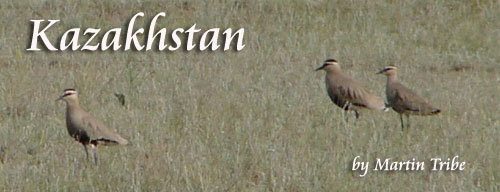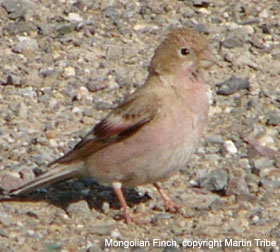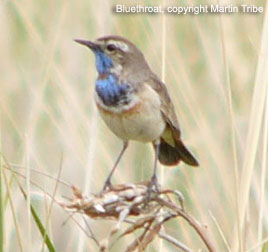Day 1: The group arrived in Almaty early morning and were greeted by Sveta, Vaughan and rain! The rain did not dampen our enthusiasm for birding however, but we had to wait a short while until we had driven to the foothills of the Tien Shan Mountains, currently mostly hidden by low cloud.
Our first stop was a village with plenty of trees. We soon found three
Azure Tits, Hume's Warbler and a fine male
Common Rosefinch plus noisy
Common Mynas and as we were about to leave, a pair of
Brown Dippers on the nearby stream. Further up the mountain road we added a singing male
Blue Whistling-thrush, Greenish Warbler, Grey Wagtail and heard the more familiar sound of
Eurasian Blackbird echoing from the wooded mountainside.
Higher up, the mountains had disappeared into the mist but we still added the
tianschanica subspecies of
Eurasian Treecreeper and the
bactriana subspecies of
Eurasian Magpie, the latter having noticeably more white in the wings. The familiar sound of
Common Cuckoo came through the mist, not a bird one normally associates with mountains. Our resting place for the night was an astronomical observatory at about 2800m. The mist was thick now so we took our time settling in but still birded around the observatory getting brief views of
Water Pipit and
Carrion Crow. Vaughan found a sleeping female
Common Crossbill huddled against a tree trunk and we had brief views of
Sulphur-bellied Warbler and
Severtsov's Tit-warbler.
Later the mist cleared and the sun shone so we headed outside to check out the juniper and spruce enjoying a good view of a singing male
Himalayan Rubythroat before the mist returned. Determined to carry on birding we followed the sound of finch-like calls and began to realise there were a lot of birds about, albeit hard to see. The finally cleared and we were soon watching groups of the rather plain-looking
Hodgson's Mountain-finches feeding and flying around us. Amongst them were at least ten
Brandt's Mountain-finches (a bird normally found much higher up and one we were glad to see as they are normally hard to find) and
Red-fronted Serins. As we watched these birds we found a singing male
Brown Accentor, soon followed by a second and had brief views of an
Altai Accentor.
Back amongst the bushes and trees we saw two more
Sulphur-bellied Warblers and a
Greenish Warbler. In the distance a curlew-like call indicated the presence of male Himalayan Snowcocks - a bird to hunt for tomorrow.
Day 2: We were delighted to awake to a clear sky, superb views of the mountains all around us and snowcocks calling. After breakfast, we drove up to another observatory situated 3300m up in the mountains. On the way up, we had good views of an
Altai Accentor and a few Water Pipits. At the observatory we immediately picked up a fine male
Güldenstädt's Redstart, which was quickly followed by both
Red-billed and
Yellow-billed Choughs. Altai Accentors were again seen and we were a bit surprised to find a female
Black Redstart.
We moved to a site that overlooked three mountain ridges where we could hear a
snowcock calling. Soon three were seen briefly in flight but unfortunately not by the entire group. A male however, could still be heard and wasn't that far away. After a few tense minutes the bird decided to sit up on a boulder and showed superbly. As we hunted for the snowcock, we had picked up more Hodgson's Mountain-finches, at least ten more Brandt's Mountain-finches and a pair of
White-winged Grosbeaks.
Back down at the lower observatory, the weather was still good so we set about thoroughly exploring the spruce trees and juniper bushes. A male Himalayan Rubythroat sang from the top of a spruce tree whilst a
Black-throated Accentor sang from another closeby. On a nearby bush we then found a singing male
Eversmann's Redstart. What a place this is and treetops seemed the place to look as a Common Cuckoo called from one and a male White-winged Grosbeak from another. We again picked up Sulphur-bellied and Greenish Warblers and Severtzov's Tit-warbler and added
Mistle Thrush.
Suddenly the two Russian-speakers with us began shouting urgently at each other; we looked around frantically and most saw at least one bird fly quite low overhead. The excitement was because we had been overflown by two or possibly more
Red-breasted Rosefinches, a bird of high and inaccessible mountains and one almost never seen. Immediately this was followed by a male
Red-mantled Rosefinch flying over for comparison!
Next it was time to hunt for one of the birds most people come here to see, Ibisbill. Yesterday was had driven past Great Almaty Lake in the mist without seeing it but today it was showing in all its glory. The lake held four pairs of
Ruddy Shelduck, (it is strange to watch these birds flying around rock-strewn mountainsides), and, after a brief search, a superb
Ibisbill. A falcon-like call drew our attention to a
Merlin of the race
lymani and we also found
Common Raven, a female Red-mantled Rosefinch and the
rufipectus race of
Coal Tit.
It was now time to head down to the lowlands, of course birding en route. Our first stop added a soaring
Northern Goshawk and we heard
Spotted Nutcracker, Common Whitethroat and
Western Grasshopper-warbler. Our fourth species of redstart for the day was found in the form a superb male
Blue-capped Redstart whilst Brown Dippers showed well on the river and we heard the strange sound of
Corn Crakes calling from very steep grassy slopes. Three
Oriental Turtle-doves showed well by the side of the road and the male Blue Whistling-thrush sang again for us.
Day 3: Today we covered the Sorbulak Lake area, a place of scattered lakes surrounded by arid semi-desert, in a very sturdy, high ground-clearance vehicle. En route to the lake we picked up
European Roller, European Bee-eater, Lesser Grey Shrike, Masked Wagtail and
Mallard. At the lake we were treated to the spectacular sight of a colony of approximately 10,000
Rose-colored Starlings nesting amongst the boulders, with flocks constantly flying over our heads.
At various spots around the many lakes of the area we added
Dalmatian and
Great White Pelicans, Garganey (a very common duck here),
Red-crested Pochard, Little Ringed Plover, 23
Terek Sandpipers, Temminck's Stint, Caspian Gull, White-winged Tern, Oriental, Sky, Greater Short-toed, Lesser Short-toed, Crested and
Calandra Larks, Hoopoe and
Red-headed Bunting.
A search of a small wood yielded
Barred Warbler and
Blyth's Reed-warbler and nearby we found a male
Red-backed Shrike. There were some areas of reedbed and although relatively small, held singing
Great Reed-warblers. We saw several perched up singing on the reeds very well before a
Western Marsh-harrier decided to drop in!
Our packed lunch was consumed at another large lake where we picked up some more new species:
Little Bittern, Great Egret, Little Tern, Common Kingfisher, Black-headed Wagtail and
Sykes's Warbler whilst the House Sparrows here were of the
bactrianus race. These birds are highly migratory and are a potential split from House Sparrow.
Next, we stopped at small woodland to search for Shikra. First we picked up a circling
Black Stork and then a
Long-legged Buzzard before the Shikra appeared and showed extremely well. Moving away from the lakes, we continued our journey finding
Pied and
Isabelline Wheatears, Spotted Flycatcher, Isabelline and
Lesser Grey Shrikes, Tree Sparrow and the
halimodendri race of
Lesser Whitethroat at a roadside stop.
After an excellent day, we headed for our camp from the main road across the Taukum Desert. Shortly after leaving the road, we came across a group of 12
Greater Sandplovers, the males in full summer plumage. At a small waterhole near the camp we picked up Temminck's Stint, Lesser and Greater Short-toed Larks, Isabelline Wheatear and two Ruddy Shelduck.
Four Black-bellied Sandgrouse flew past as did a single Greater Sandplover and we found a pair of
Red-headed Buntings. Finally, a pair of
Demoiselle Cranes were 'scoped' in the fading light. Our camp was amazing with everyone being assigned their own Yurt (traditional Kazak nomads accommodation) complete with electric lights, power points, beds and carpets! Outside each Yurt was a washbasin and the toilets and showers were in little tents and we even had hot water in the showers! The dining tent was huge and the food remarkably good, we were certainly not roughing it!
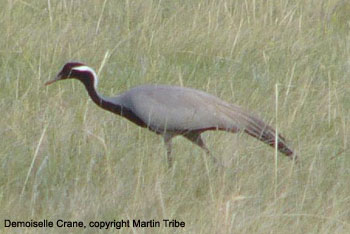 Day 4:
Day 4: Today we drove further into the desert, stopping and scanning. Soon, we were watching a fine displaying male
Macqueen's Bustard. During the morning we saw seven of these magnificent birds, displaying, standing and flying. Four Black-bellied Sandgrouse were watched as they sat on the ground and we found migrants in the form of Spotted Flycatcher and Blyth's Reed-warbler.
Various stops to scan specific vegetation soon added a pair of superb
Caspian Plovers - a highlight of the trip for many. We next stopped at a ruined house that had the only tree for literally miles around. In this tree were nesting House (Bactrian) and Spanish Sparrows. The area also added our first
Bimaculated Larks and a
Steppe Grey Shrike (
Lanius meridionalis pallidirostris). Lesser Whitethroats and Syke's Warblers were again seen as were three Horsefield's Tortoises and a young Persian Gazelle (now very rare and hard to see).
The afternoon was spent at a rocky canyon with ancient petroglyphs. En route we picked up the 'usual' common larks plus
White-winged Lark which occasionally breeds in the area and Hoopoe and
Eurasian Hobby. Arriving at the canyon, Red-headed Buntings showed well together with two male
Grey-necked Buntings whilst the rocky slopes were home to
Chukars and Pied Wheatears. Our main target bird was
Eastern Rock Nuthatch and it didn't take too long to find complete with its amazing nest. Both Isabelline and Red-backed Shrikes were also seen together with a soaring
Golden Eagle but the grand finale was saved until just before we left with 2
Desert Finches coming down to drink.
On the way back to the camp we found more White-winged Larks, bringing our total up to an incredible eight. After dinner at the camp, a few of the group were fortunate to see a
European Nightjar flying through the camp.
Day 5: Sadly leaving camp, we drove to an area known as the Barkhans, rolling scrub-covered sand dunes interspersed with small lakes closer to Lake Balkhash. Mike's shout of
'Eagle Owl' had quickly stopped the bus and clambering over the first hill where we admired two huge Eurasian Eagle-owls flying slowly over the desert, mobbed by
Brown-necked Ravens. They then perched on bushes a few hundred yards away glaring at us for disturbing them!
The first lakes held
Red-crested Pochard, Ferruginous Duck and
Black-winged Stilt whilst the bushes and reeds held the large-billed
pyrrhuloides race Common Reed Buntings looking very pale on the back, plus 'Caspian' Common Reed-warblers and Cetti's Warbler. At our second stop, we added two Azure Tits, the Siberian race of Common Starling, Grey Heron, Great Bittern in flight, Shikra and a group of seven Eurasian Honey-buzzards soaring overhead.
Our target here was
Black-headed Penduline-tit but we could only find
White-crowned Penduline-tit, albeit incredibly close views. This area used to be a good site for Black-headed Penduline-tit but it seemed that the White-crowneds had pushed them out. Nearby trees held at least eight Eurasian Golden Orioles,
White-winged Woodpecker, Common Nightingales and a pair of breeding
Turkestan Tits. Rob suggested a stop further on, at another reed bed. This proved an excellent idea as we saw a close female
Black-headed Penduline-tit here - a very nice looking bird.
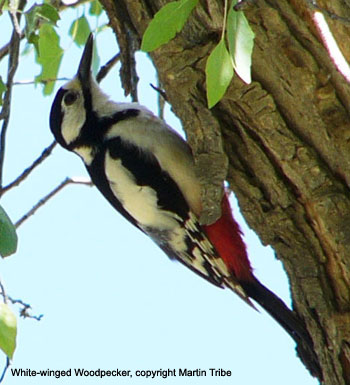
Driving on, we stopped at a small patch of woodland comprising endemic turanga trees. Here we again saw White-winged Woodpecker and
Turkestan Tit whilst we added the highly sought-after Eversmann's Dove to the list. After lunch in the woods we drove over the Ile River, stooping on the bridge to admire two Citrine Wagtails, and on to a Muslim cemetery situated in an area of bushes and small trees in another part of the desert. Here we added European Turtle-dove to the list as we walked to the cemetery where we were soon watching our target species,
Saxaul Sparrow, nesting in the mausoleums alongside Eurasian Tree Sparrows. In the surrounding bushes we found several other good species: Pied Wheatear, Sykes's and Asian Desert Warblers and singing in the open almost together, Common Nightingale and
Rufous Bush-robin. We arrived back to our hotel in Almaty early evening and a few people saw
European Scops-owl after dinner. Much rarer however, a Tawny Owl was heard calling in the grounds.
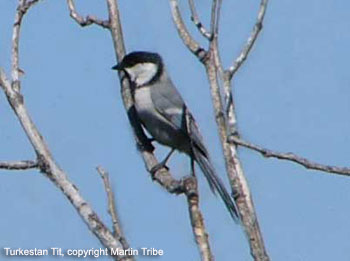 Day 6:
Day 6: Today we headed east to a stakeout at an artesian well in the desert. En-route, we saw a pair of Demoiselle Cranes,
Montagu's Harrier and four
Alpine Swifts. At the waterhole we soon picked up at least 12
Desert Finches, lots of Black-bellied Sandgrouse (some landed on the ground nearby and walked to the water), Eurasian Hobby, Barred Warbler, Isabelline Wheatear and Isabelline Shrike. Eventually, three of our target species,
Pallas's Sandgrouse were seen flying over. In flight they were noticeably different from the Black-bellieds and when they called they sounded quite different. Because of late rains we were very fortunate to see this species as they were not coming in to their normal drinking places.
Next, we drove up the Kokpek towards China, stopping for lunch at a nest site of
Egyptian Vulture where we found a clean-looking adult on a nest plus Chuckars, Golden Eagle, Red-headed and Grey-necked Buntings and two very sandy-coloured
Little Owls. In the stunningly beautiful Charyn Canyon area (geographically the centre of the Eurasian continent and further from the ocean than any other place on earth) we picked up
Monk Vulture, Rock Petronia, Eurasian Crag-martin and
Lammergeier and two very white-looking
Horned Larks. Two further (emergency!) stops added
Booted Eagle and
Steppe Eagle.
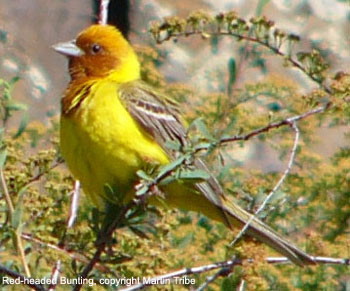
Our final scheduled stop of the day was at a waterhole in another part of the desert. It's a good thing we were with people who knew where they were going - we really were miles from anywhere! We settled down to watch the water and were soon admiring
Mongolian Finches (about 100 came to drink in the hour or so we were there) together with Grey-necked Buntings, Rock Petronias, a female Common Rosefinch, 'Bactrian' House Sparrows, Eurasian Linnets and the highlight for all,
Crimson-winged Finch, at least three males and a female. Very classy birds and extremely rare in Kazakhstan. Returning to the bus a
Rufous-tailed Rock-thrush showed well on the rocky slope. Returning to our small hotel in Chilik wasn't quite the end of the birding, as we went to dinner we found two
Grey-headed Goldfinches in a tree in the grounds and after dinner a few of the group went for a walk and found a European Scops-owl.
Next stop was a village, on the outskirts of which there was a colony of
Plain Martins (variously thought to be a sub-species of Sand Martin or a species in its own right and noticeably different from Sand Martin). Eurasian Tree Sparrows also seemed happy nesting in holes in the sandy banks. Then it was back up the Kokpek Pass where we checked a couple of rocky gorges The first gorge behind the cafes (which became affectionately known as Toilet Canyon because of the toilets at its base), yielded a superb soaring
Saker,
Himalayan Griffon-vulture, four Chukars, Rock and
Whitecapped Buntings and
Hume's Whitethroat. The second gorge higher up gave us a male Saker chasing Rose-coloured Starlings, four Golden Eagles, an
Eastern Imperial Eagle, a pair of each of Rufous-tailed and Blue Rock-thrushes, a very pale Great Tit and both buntings again. Driving down the Kokpek Pass again, we returned to Almaty for the night.
Day 7: The day started with Laughing Dove by the hotel plus the Grey-headed Goldfinches again along with the
turkestanicus race of Common Greenfinch. Yesterday we stopped briefly at yet another waterhole but had seen only Little Ringed Plover and a few Black-bellied Sandgrouse. Today we were back at this waterhole to give it a proper look. We had excellent views of Black-bellied Sandgrouse with at least 120 seen. Also in the area were a male Montagu's Harrier, a few
Long-legged Buzzards, Eurasian Hobby, Lesser Kestrel, Greater Sandplover, Hoopoe, Tawny Pipit and Black-headed Wagtails.
Day 8: Today was the long drive to Alakol Lake, over 600 km, but on a much-improved road. Roadside birds included European Bee-eaters, Eurasian Rollers, Hoopoes, four Steppe Eagles, Long-legged and
vulpinus Common Buzzards, Lesser Grey Shrikes, Common Cuckoos and Red-headed Buntings. One stop gave us nesting
Eastern Rock Nuthatch, another added
casiotis Common Wood Pigeons and
sommeringii Eurasian Jackdaws, both of which we saw at various other places during the trip. At Alakol Lake after checking into our comfortable lakeside resort, we searched the beach area where we found a nice summer-plumaged
Black-throated Diver together with lots of Common and Little Terns and Caspian Gulls. Waders included Terek Sandpiper, Ruddy Turnstone, Eurasian Oystercatcher and Little Ringed Plover whilst ducks included Red-crested Pochard, Ruddy Shelduck and Common Goldeneye. There were also Masked and Citrine Wagtails, lots of Common Nightingales and Eurasian Tree Sparrows whilst Eurasian Swallows and Sand Martins were very common here, feeding on the abundant flies and mosquitoes!
Day 9: This morning we drove to an excellent nearby marsh in glorious sunshine with the mountains reflecting in the lake. The red-spotted form of
Bluethroat sang,
Paddyfield Warblers and
Siberian Stonechats showed well and Black-headed Wagtails were abundant. A walk through the grass gave us flight views of four
Common Quail. The marsh held Great Egret, Grey Heron, Greylag Goose, Mute and Whooper Swans, Northern Pintail, Gadwall and Northern Shoveler, the eastern race of Eurasian Curlew (
orientalis), Common Redshank, Kentish Plover, Black-winged Stilt, Pied Avocet, Little Stint in summer plumage, Northern Lapwing, Collared Pratincole and White-winged Terns. Out over the lake, another Black-throated Diver, Dalmatian Pelicans and Great and Common Black-headed Gulls could be seen but by far the most unexpected bird was however, an adult summer-plumaged
Red-necked Stint. Another marshy area added Red-necked and Black-necked Grebes, Common Snipe and Common Shelduck whilst Common Swift of the
pekinensis race flew overhead.
In the afternoon we drove up into the nearby Dzungharian Mountains and birded some gentle scrub-covered slopes in the shadow of huge mountains. Red-billed Choughs were seen together with Black (Black-eared) Kite, Monk Vulture, Eurasian Hobby and Common Kestrel and our target species,
Meadow Bunting was seen well alongside Rock Buntings for comparison. An adult Eastern Imperial Eagle showed very well, gently soaring closer and closer whilst Red-fronted Serins and Rose-coloured Starlings flew overhead and we had a surprise in the form of a
Black Stork soaring down the valley and landing by the nearby stream.
Day 10: A quite long drive to visit to another marsh added yet more species. The already-seen species included Long-legged Buzzard, Isabelline Shrike, at least six Siberian Stonechats, Sky Larks and Cetti's Warblers and as well as Montagu's Harrier, we found our first
Pallid Harrier, a fine male, which obligingly landed on the path about fifty metres from us. We also found a singing male Barred Warbler that was soon followed by our target species, a singing
Pallas's Grasshopper-warbler. Stock Dove and Richard's Pipit were also added to the list here. In the afternoon we drove to the west end of the lake but winter storms had radically changed the coastline and we saw very little apart from billions of 'killer' mosquitoes. We were all very glad that the itinerary had been changed and we no longer had to camp here but had comfortable accommodation elsewhere!
Day 11: After an early-morning lake-watch, it was time to leave Alakol Lake and drive back to Almaty but Eurasian Sparrowhawk seen before we left was new for the trip. On the way back to Almaty we again stopped at the Eastern Rock Nuthatch site where we saw both adults and could see also see young in the nest. Also here were two male Blue Rock-thrushes, a male Pied Wheatear, Rose-coloured Starlings a Red-headed Bunting and
Bactrianas House Sparrows.
Day 12: Today we were to flew north to Astana for the extension to the main tour: an option no-one had declined. Before we left the hotel in Almaty we had recorded two new species for the trip: Ring-necked Pheasant and Hooded Crow, now it was time for the Steppe.
We left Astana after a delay caused by the Estonian Prime Minister and his entourage and headed for the Kurgalgin Nature Reserve comprising lakes and steppe grassland. There really aren't many natural trees in the steppe so at a roadside plantation, we were pleased to see
Red-footed Falcons. Carrying on, we soon began to see our first
Black Larks and of course, stopped for them. As we watched more male Black Larks feeding by the roadside of this remarkably flat land, we checked an adjacent green area and although we couldn't see any water, it was obviously a marsh as White-winged Terns were abundant and nesting here together with
Black-tailed Godwits and
Marsh Sandpipers. Garganey swam through what looked like grass and our first
Black-winged Pratincoles were seen together with Sykes's Yellow Wagtails and Citrine Wagtails. The 'yellow-legged' type gulls here were all Steppe Gulls (subtly different from the Caspian Gulls we had been watching previously) and we found a
vulpinus Steppe Buzzard.
A stop at a large lake was very productive with
Twite of the steppe form being a good bird to find and we also saw our first
Northern Wheatears. The lakeshore held numerous Common Black-headed and Steppe Gulls, a few Common Gulls and five Slender-billed Gulls. Waders included Little Ringed Plover, four Little Stints, two Curlew Sandpipers, a Wood Sandpiper, two Marsh Sandpipers, and many (although only a few were close)
Red-necked Phalaropes. A mile or so on we stopped for a large raptor on a telegraph pole and added a magnificent
White-tailed Eagle to the list. That evening after checking into our pleasant lakeside cottages, we saw reeling
Savi's Warbler, a very pale race of
Bearded Parrotbill, Paddyfield Warblers and 'Caspian' Reed-warblers.
Day 13: Our base for three nights was on the shore of the largest lake of the area. We were now deep in the reserve, a place no other tour company visits, and we in the hands of a knowledgeable local guide, Alexei. We began the day with Savi's Warblers reeling then headed to check some nearby smaller lakes. The first one held at least two pairs of
White-headed Ducks along with Tufted Duck and Common Pochard. A pair of Red-necked Grebes was seen here plus 31 Whooper Swans, two Great Black-headed Gulls, hundreds of Great Cormorants (seen in large skeins throughout the days we were in the area) and Isabelline Shrike. We also saw the
incognita race of Common Reed Bunting, with a smaller bill than the southern birds and a huge nape area. An area of bushes with a few small trees was our next stop. Here a pair of
pallidus Merlins were nesting - very pale, small, sandy-coloured birds looking quite different to the north European birds. Two Short-eared Owls also showed well here as did a Western Grasshopper-warbler.
A Black-winged Pratincole colony was our next stop and we had excellent views of these birds, both on the ground and in flight and nearby we added
Caspian Tern to the list. Next was a key species for any trip here, near a village we scanned the short grass and quickly located a flock 11
Sociable Lapwings, a rare and declining species these days. We were treated to wonderful views of these enigmatic birds and later found two more bringing our total to an impressive 13.
A stop at another small bushy area provided us with some nice birds: Bluethroat, Siberian Stonechat, Paddyfield Warbler and our target species,
Booted Warbler with two seen incredibly closely. Other stops at various lakes during the day produced many of the same birds but of particular note were 173 Whooper Swans, 200+ Greylag Geese, 93 Red-crested Pochards, 52 Garganey and 150 Caspian Terns.
Day 14: Yesterday had been highly successful and as there was no pressure today to find any target species, we just enjoyed our birding. We firstly birded the local area enjoying the Bluethroats that were nesting around the huts in which we were staying, finding more Savi's Warblers and Bearded Parrotbills and admiring breeding-plumaged Black-throated Divers. After lunch, we drove to a different lake in search of
Greater Flamingo. Here we found 13 Pied Avocets, 115 Curlew Sandpipers, 300+ Slender-billed Gulls, 100+ Red-necked Phalaropes and 27 Greater Flamingoes. Two stunning male
Pallid Harriers and a few Twite were seen en-route but the real excitement was a torrential thunderstorm which nearly resulted in us becoming stuck in the mud!
Day 15: Sadly, it was time to drive back to Astana for the flight back to Almaty. We stopped at various sites seeing birds such as Merlin, Steppe Eagle and Demoiselle Cranes for the last time and enjoying stunning views of both
Western Marsh-harrier and
Pallid Harriers hunting and five
Red-footed Falcons - two adult males, two young males and a female. Near Astana we added Yellowhammer to the list and saw our first European Bee-eater for a few days. Arriving back in Almaty we transferred back to our hotel again.
Day 16: We left early to catch our flight back to the UK via Istanbul, reaching London in the afternoon (UK time). It had been a superb trip, with, as one person said, good views of everything. We had seen some birds normally very hard if not almost impossible to see in Kazakhstan, or indeed anywhere else, plus different races of birds we were more familiar with. The
trip total was 248, a new record for this tour, achieved thanks to excellent local knowledge and great birding by all participants.
